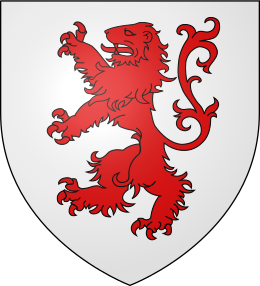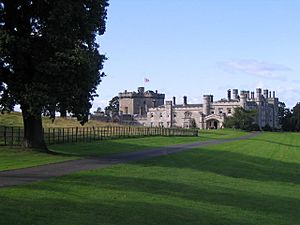Clan Dundas facts for kids
Quick facts for kids Clan Dundas |
|||
|---|---|---|---|
| Dun deas | |||
| Profile | |||
| Region | Lowlands | ||
| District | West Lothian | ||
| Chief | |||
 |
|||
| David Duncan Dundas of Dundas - lived in South Africa, and moved to Canada in 2006 | |||
| Dundas of Dundas | |||
| Historic seat | Dundas Castle | ||
|
|||
|
|||
Clan Dundas is a famous Scottish clan with a long and interesting history. The clan comes from the Scottish Lowlands, specifically the West Lothian area.
Contents
History of Clan Dundas
How the Clan Started
The Dundas family has a very old history. Some people say their ancestors came from a person named Helias. He was related to Gospatrick, a Prince of Northumberland.
The first clear records of the family are from the time of King William the Lion. A person named Serle de Dundas is mentioned in a document from that period. Later, in 1296, Serle de Dundas and Robert de Dundas signed the Ragman Rolls. This meant they promised loyalty to King Edward I of England.
Dundas in the 1400s and 1500s
Sir Archibald Dundas was a favorite of King James III of Scotland. The king sent him on important trips to England. King James III wanted to give Sir Archibald a high rank. However, the king died before he could do so.
The next king, James IV of Scotland, did give lands to Sir Archibald. These lands included the island of Inchgarvie. Sir Archibald was also given the right to build a castle there.
Over time, the Clan Dundas family grew. Important branches of the clan included the Dundases of Blair Castle, Arniston, Duddingston, and Fingask.
The 1600s and the Civil War
George Dundas was the eighteenth chief of the clan. He was a strong Presbyterian and fought in the Wars of the Covenant. These wars were about religious freedom in Scotland. George Dundas was part of the group that tried James Graham, 1st Marquis of Montrose.
Dundas was put in charge of Linlithgowshire to defend it. He had to protect it from Oliver Cromwell's army.
The Dundases of Arniston were a very important part of the clan. They became famous for holding high legal and political jobs. Sir James Dundas, the first of Arniston, was the Governor of Berwick. This was during the time of King James VI of Scotland.
His son, Sir James Dundas, Lord Arniston, was knighted in 1641 by King Charles I. He also served in the Scottish parliament for Mid-Lothian. Lord Arniston was loyal to the King. However, he strongly disagreed with the King's actions regarding the Church of Scotland. He especially did not like the return of bishops. He was one of the first to sign the National Covenant.
After the King was restored to power in 1660, Lord Arniston was offered a seat on the supreme court. He took the job as Lord Arniston in 1662. But he did not stay long. He refused to sign a declaration in 1663. This declaration said that the National Covenant and the Solemn League Covenant were against the law.
The 1700s and Jacobite Risings
William Dundas of Kincavel was an ancestor of the Blair Castle branch of the clan. He was a Jacobite, meaning he supported the Stuart kings. He was put in prison for his part in the Jacobite rising of 1715.
Sir David Dundas was born in Edinburgh in 1735. He grew up to become a very important military leader. In 1809, he became the commander-in-chief of the British Army.
Modern History of the Clan
The twenty-eighth chief of Clan Dundas was Admiral Sir Charles Dundas of Dundas. He was an Aide-de-camp (a personal assistant) to King George V. During World War I, he was the main naval transport officer. This meant he was in charge of moving ships and supplies for the navy.
His son, Adam Duncan Dundas of Dundas, became the 29th Chief in 1924. He served as a major in the Territorial Army during World War II. He was a battery commander, leading a group of artillery guns.
Clan Dundas Tartan
| Tartan image | Notes |
|---|---|
 |
This is the Dundas tartan. It was first shown in a book called Vestiarium Scoticum in 1842. |
See also


